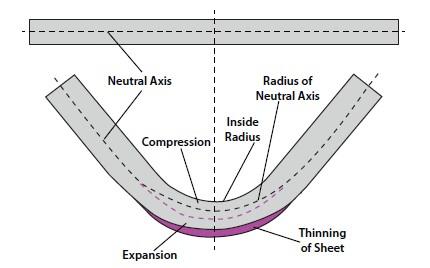The bend radii listed are standard minimum if manufacturing for aircraft and aerospace applications.
Minimum bend radius sheet metal aluminum metric.
Per the aluminum association inc.
When the sheet metal is put through the process of bending the metal around the bend is deformed and stretched.
Understanding the bend allowance and consequently the bend deduction of a part is a crucial first step to understanding how sheet metal parts are fabricated.
The minimum bend radius data shown in these charts is measured to the inside of the bend.
The minimum inside bend radius is even larger when bending with the grain.
Aluminum minimum bend radii for 90 degree cold forming of sheet and plate.
It is possible to choose other bends if you require but additional lead time and tooling charges may apply.
Since commercial sheet metal bending can be done with less concern for stresses caused during forming operation the radius can be near zero for thin sheet metal.
3003 h14 is extremely ductile.
Sheet metal bend radii if these guidelines are not followed more research and or some form of analysis may be requried.
Minimum sheet metal flange bend length is required to avoid cracks in the bending area.
Minimum sheet metal flange bend length 3 x sheet thickness bend radius.
Minimum hole diameter guidelines.
Brittle metal such as aluminum generally requires a larger bend radius than ductile material like cold rolled steel.
It requires an inside bend radius of at least 6x the material thickness.
Radii for various thicknesses expressed in terms of thickness t.
The tables below show bend radii and minimum bend sizes for materials and tooling combinations stocked by protocase.
In steel between 0 5 and 0 8 in.
Table 1 preferred recommended 90 degree bend radii for various sheet metals.
As this happens you gain a small amount of total length in your part.
Aluminum where necessary 5052 h32 may be bent to 1t and 6061 t6 to 1 1 2t.
Bend radii minimum bend sizes.
Use this document to choose values that are both manufacturable and meet your needs.
Thick grade 350 and 400 may have a minimum bend radius of 2 5 times the material thickness when transverse bending while longitudinal bending may require a minimum bend radius that s 3 75 times the material thickness see figure 1.
Discover all our calculation tools in the calculators section of the top menu.
5052 h32 aluminum bends in about the same way as mild steel.
It shall be equal to three times of sheet thickness plus bend radius.
We go beyond the general rules of sheet metal bending as our customers want tight bend radii for sheet metal parts.
It is most economical to use a single bend radius throughout the design but if necessary you can utilize multiple radii.
The tool can calculate the required bending force for bending aluminum stainless steel mild steel and weldox or strenx high strength steels.

